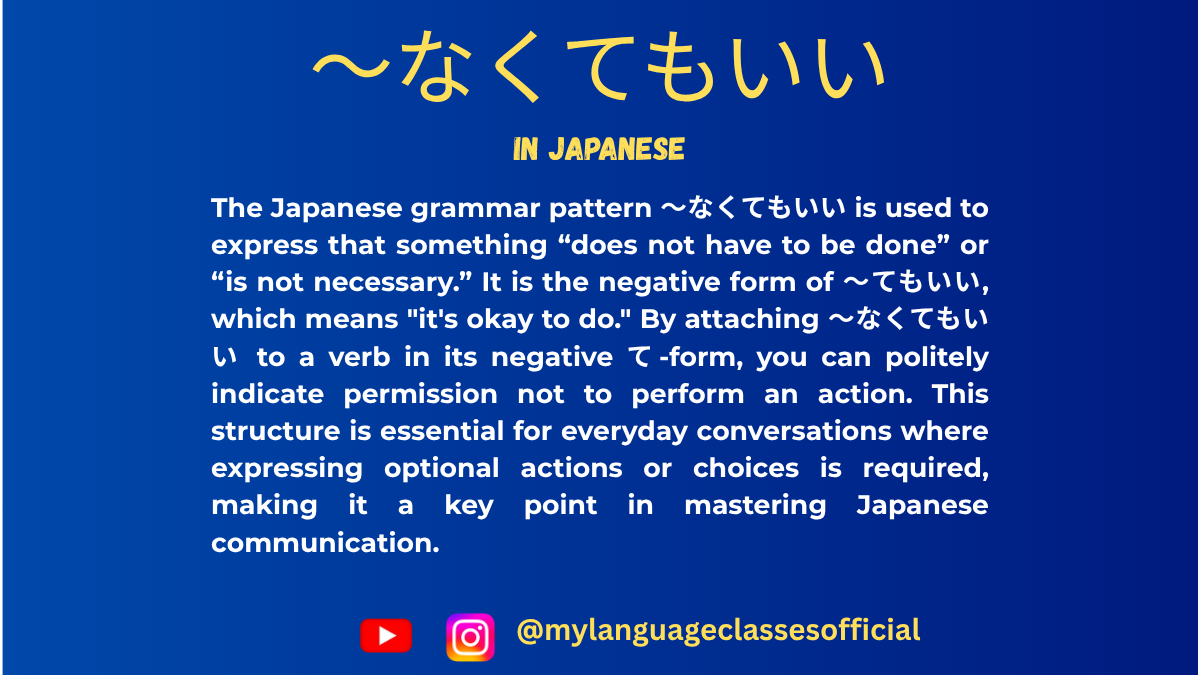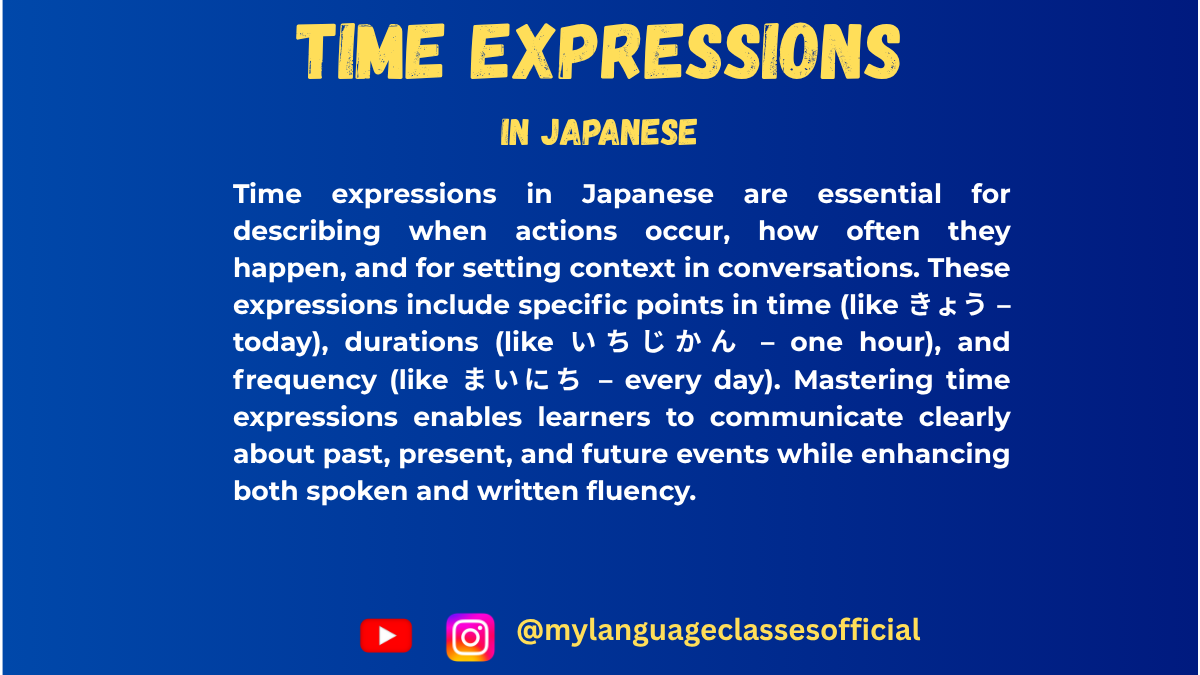Your cart is currently empty!
Tag: japan
-

Understanding 〜でしょう/だろう in Japanese | My Language Classes
Expressions used to indicate probability, conjecture, or seeking confirmation
If you’re diving into the world of Japanese grammar, the particle でしょう (deshou) is one you’ll encounter frequently. It’s a versatile expression that conveys probability, speculation, or seeks confirmation. In this blog post, we’ll explore all the nuances of でしょう, its various uses, and how it interacts with other elements of the language.
1. What is でしょう?
でしょう is the polite form of だろう, which itself is derived from the copula だ (used to state facts). Depending on the context and tone, it can mean:
- “Probably”
- “I suppose”
- “Right?” (as a tag question seeking agreement)
- “It seems that”
Forming でしょう
- Nouns/Na-adjectives:
Add でしょう after the plain form.
Example:
学生 でしょう。 (It’s probably a student.) - I-adjectives:
Attach directly to the base form.
Example:
暑い でしょう。 (It’s probably hot.) - Verbs:
Attach to the plain form.
Example:
行く でしょう。 (He/she/they will probably go.)
2. Expressing Probability
One of the most common uses of でしょう is to express probability or likelihood. It’s often used when the speaker wants to indicate that something is likely true based on their knowledge or perception.
Examples:
- 明日は雨が降る でしょう。
(It will probably rain tomorrow.) - あの映画は面白い でしょう。
(That movie is probably interesting.)
In these cases, でしょう is equivalent to saying “probably” or “I think” in English. It softens the statement, showing that the speaker is not asserting something as a definite fact.
3. Asking for Confirmation
When used with a rising intonation, でしょう turns into a tag question, seeking agreement or confirmation from the listener. It can be translated as “right?” or “isn’t it?” in English.
Examples:
- このケーキ、美味しい でしょう?
(This cake is delicious, isn’t it?) - 彼は先生 でしょう?
(He’s a teacher, right?)
The rising tone at the end signals the speaker is looking for confirmation or agreement.
4. Making Guesses or Predictions
You’ll often hear でしょう in weather forecasts, news reports, or any context where predictions are made.
Examples:
- 明日の天気は晴れ でしょう。
(Tomorrow’s weather will probably be sunny.) - この問題は簡単 でしょう。
(This problem is probably easy.)
In such cases, the speaker uses でしょう to make a statement that isn’t 100% certain but is backed by reasonable evidence or context.
5. でしょう in Casual Speech: だろう
In informal situations, だろう is often used instead of でしょう, especially by men. While だろう serves the same functions, it feels less polite and more casual.
Examples:
- あれは本物のダイヤモンド だろう。
(That’s probably a real diamond.) - 今日は忙しい だろう?
(You’re busy today, right?)
6. Negative Forms
The negative equivalent of でしょう is formed by negating the predicate or verb.
Examples:
- あのレストランは高くない でしょう。
(That restaurant is probably not expensive.) - 彼は来ない でしょう。
(He probably won’t come.)
7. Using でしょう in Hypothetical or Conditional Contexts
When paired with the conditional たら or similar structures, でしょう can express speculation about hypothetical situations.
Examples:
- あの店に行ったら、何か美味しいものがある でしょう。
(If we go to that store, there will probably be something delicious.) - もっと勉強したら、試験に合格する でしょう。
(If you study more, you will probably pass the exam.)
8. Cultural Nuances and Subtleties
In Japanese communication, でしょう plays a role in maintaining politeness and avoiding direct assertions. By using でしょう, the speaker softens their statements, allowing room for the listener’s interpretation or input. This aligns with Japanese cultural norms that emphasize indirectness and respect for others’ perspectives.
For example:
- 今日は寒いです。 (It’s cold today.)
→ Direct and factual. - 今日は寒いでしょう。 (It’s probably cold today.)
→ Politer, leaving room for the listener’s agreement or alternative opinion.
9. Common Pitfalls and Misunderstandings
- でしょう vs かもしれない:
Both express uncertainty, but かもしれない conveys a lower degree of certainty compared to でしょう.
Example:
彼は来る でしょう。 (He will probably come.)
彼は来る かもしれない。 (He might come.) - Overuse in Confirmation Questions:
While でしょう is great for seeking agreement, overusing it can make your speech sound repetitive. Balance it with other expressions like よね or ね for variety.
10. Final Notes
Mastering でしょう allows you to add nuance to your Japanese and navigate conversations more smoothly. It’s a fantastic tool for expressing uncertainty politely, making predictions, or asking for confirmation. Remember:
- Use でしょう for polite speech and だろう for casual contexts.
- Pay attention to intonation when seeking confirmation.
- Practice with real-life scenarios to internalize its subtleties.
Do you have any questions about でしょう or other Japanese grammar points? Share them in the comments below, and let’s learn together! 😊
If you enjoyed this lesson, be sure to check out more posts like this on my blog at My Language Classes. Don’t forget to subscribe my YouTube channel and follow me on Instagram for the latest language learning tips and lessons. Leave a comment below to share your thoughts, or ask any questions you have about nouns.
Happy learning! 😊
-
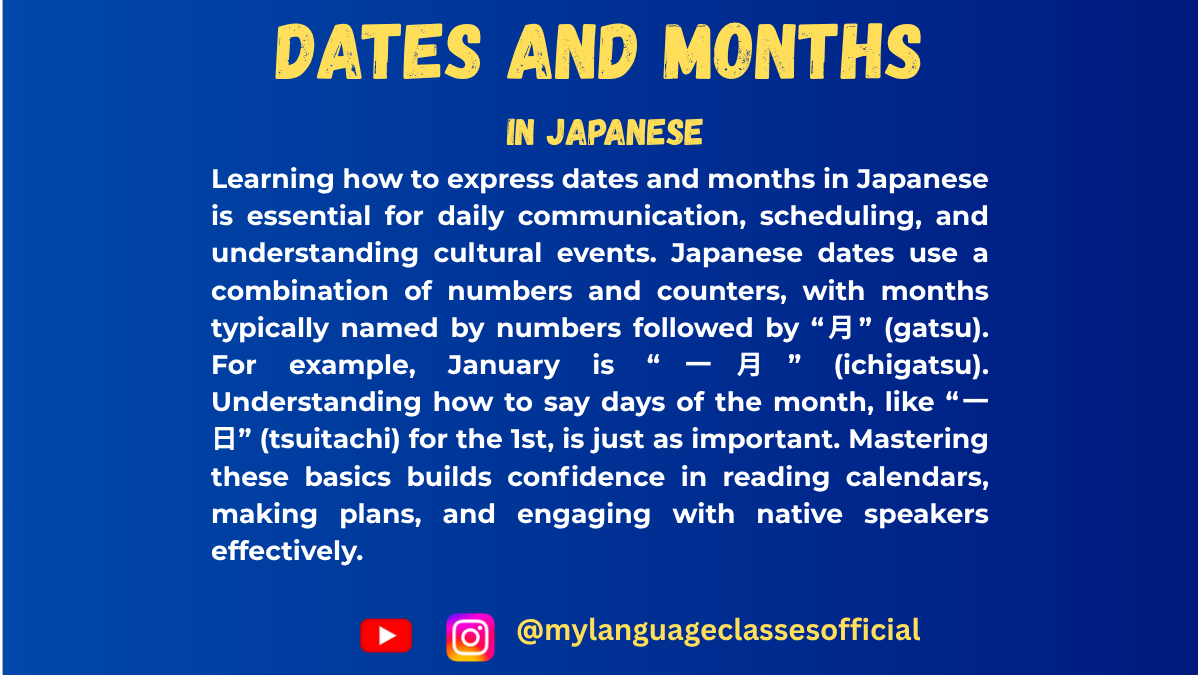
Mastering Dates and Months in Japanese | My Language Classes
Dates and Months in Japanese
こんにちは (Konnichiwa)!
If you’re learning Japanese, one of the essential skills is telling the date. Japanese has unique ways to express dates that differ from English or many other languages. In this post, we’ll cover everything you need to know about telling dates in Japanese, including a handy list of how to say specific dates and some cultural and linguistic nuances to keep in mind. Let’s dive in!
Understanding Japanese Dates: Basic Structure
In Japanese, the date format is typically written as Year-Month-Day (e.g., 2024年12月25日, 2024-12-25). The characters used are:
- 年 (nen) for “year”
- 月 (gatsu) for “month”
- 日 (nichi) for “day”
For example:
- 2024年12月25日 = “2024 December 25”
- Read as: にせんにじゅうよねん じゅうにがつ にじゅうごにち (Nisen-nijūyo-nen, jūni-gatsu, nijūgo-nichi)
Days of the Month in Japanese
Japanese has specific terms for the first 10 days and certain other days of the month. Here’s a list of the most common:
1st to 10th and 20th (Special Readings):
- 1日 (ついたち) – Tsuitachi
- 2日 (ふつか) – Futsuka
- 3日 (みっか) – Mikka
- 4日 (よっか) – Yokka
- 5日 (いつか) – Itsuka
- 6日 (むいか) – Muika
- 7日 (なのか) – Nanoka
- 8日 (ようか) – Yōka
- 9日 (ここのか) – Kokonoka
- 10日 (とおか) – Tōka
- 20日 (はつか) – Hatsuka
Days After the 10th:
For days after the 10th (except 20th), simply use the number + 日 (にち, nichi). For example:
- 11th = 11日 (じゅういちにち) – Jūichi-nichi
- 12th = 12日 (じゅうににち) – Jūni-nichi
- 13th = 13日 (じゅうさんにち) – Jūsan-nichi
Continue this pattern up to the 31st:
- 21st = 21日 (にじゅういちにち) – Nijūichi-nichi
- 30th = 30日 (さんじゅうにち) – Sanjū-nichi
- 31st = 31日 (さんじゅういちにち) – Sanjūichi-nichi
Months in Japanese
Months in Japanese are much simpler. They are numbered from 1 to 12 followed by 月 (gatsu). For example:
- January = 1月 (いちがつ) – Ichigatsu
- February = 2月 (にがつ) – Nigatsu
- March = 3月 (さんがつ) – Sangatsu …and so on.
Key Grammar and Usage Notes
1. No Articles:
Unlike English, Japanese does not use articles like “the” or “a.” So, you simply state the date without worrying about additional words.
2. No Plural Forms:
Japanese nouns do not have plural forms. For example, the word 日 (nichi) stays the same whether you’re talking about one day or many days.
3. Gender-neutral Language:
Japanese does not have gender-specific nouns or articles. The way you say dates remains the same regardless of who is speaking or listening.
4. Pronunciation Challenges:
- Pay special attention to the unique readings for the 1st to 10th and the 20th.
- Be careful with long vowels, such as in ようか (8th), where the “ou” sound must be elongated.
5. Cultural Context:
When writing or saying the date in Japanese, it’s common to follow the year-month-day structure. If you’re addressing someone formally, especially in written communication, add です (desu) or でございます (de gozaimasu) for politeness.
Practice Makes Perfect!
Here’s an example of a complete date in Japanese:
- Today is December 25, 2024
→ 2024年12月25日です
→ にせんにじゅうよねん じゅうにがつ にじゅうごにち です
Pro Tips for Fluency
- Memorize the unique readings for the 1st to 10th and 20th – These are the most irregular and require rote learning.
- Practice with real dates – Try saying your birthday, important holidays, or even today’s date.
- Listen to native speakers – Watch Japanese TV shows, listen to podcasts, or use language apps to hear how dates are pronounced naturally.
Now that you’ve mastered dates in Japanese, try using them in conversation! Whether you’re booking an appointment or celebrating a special occasion, understanding how to express dates will bring you one step closer to fluency.
If you enjoyed this lesson, be sure to check out more posts like this on my blog at My Language Classes. Don’t forget to subscribe my YouTube channel and follow me on Instagram for the latest language learning tips and lessons. Leave a comment below to share your thoughts, or ask any questions you have about nouns.
Happy learning! 😊
-
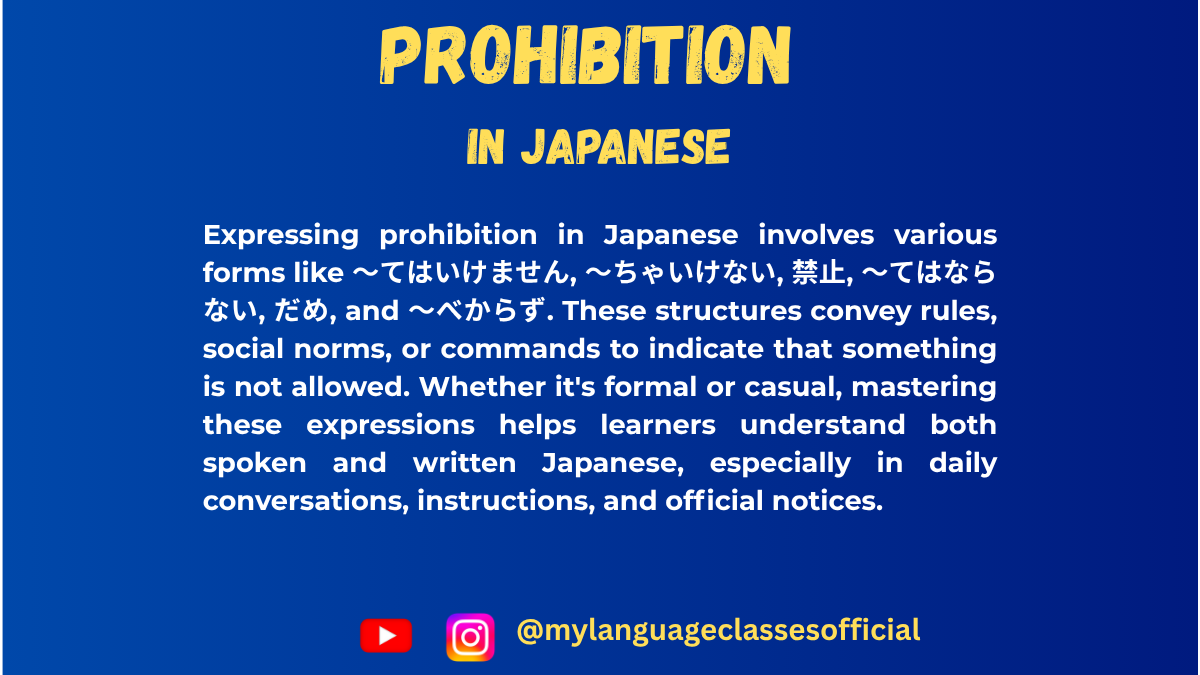
How to Express Prohibition in Japanese | My Language Classes
Expressing Prohibition in Japanese
If you’re learning Japanese, mastering how to express prohibition (saying what cannot or should not be done) is an essential step toward fluency. Japanese has a rich tapestry of expressions for prohibition, each carrying different nuances based on politeness levels, context, and the strength of the prohibition. In this blog, I’ll guide you through the most common ways to express prohibition in Japanese and help you understand when to use them.
1. ~てはいけません (Te wa ikemasen)
This is one of the most commonly used and polite ways to express prohibition in Japanese. It translates roughly to “You must not…” or “It’s not allowed to…”.
Formation:
Take the te-form of the verb and attach ~てはいけません.
Example:
- ここでたばこを吸ってはいけません。
(Koko de tabako o sutte wa ikemasen.)
“You must not smoke here.”
This phrase is often used in formal situations, such as school rules, workplace guidelines, or signs in public spaces.
2. ~ちゃダメ / ~ちゃいけない (Casual Forms)
In casual settings, Japanese speakers often use ~ちゃダメ or ~ちゃいけない to express prohibition. These are informal contractions of ~てはいけません.
Example:
- ここでゲームしちゃダメだよ。
(Koko de geemu shicha dame da yo.)
“You can’t play games here.” - あそこで走っちゃいけない。
(Asoko de hashiccha ikenai.)
“You must not run over there.”
Use these with close friends, family members, or peers, but avoid them in formal contexts.
3. 禁止 (Kinshi) – The Formal, Written Prohibition
When expressing prohibition in written form, especially on signs or official notices, the word 禁止 (kinshi, meaning “prohibited”) is frequently used.
Example:
- 飲酒禁止 (Inshu kinshi)
“Drinking alcohol is prohibited.” - 駐車禁止 (Chuusha kinshi)
“No parking.”
This construction is direct and impersonal, commonly used in public spaces to state clear rules.
4. ~てはならない (Te wa naranai)
This is a more formal and literary way of expressing prohibition. It is less common in daily conversation but can be seen in legal documents or formal writings.
Example:
- 嘘をついてはならない。
(Uso o tsuite wa naranai.)
“You must not tell lies.”
5. Use of だめ (Dame)
The word だめ (dame) itself means “no good,” “not allowed,” or “forbidden.” It’s highly versatile and can stand alone as an expression of prohibition.
Examples:
- それはだめです。 (Sore wa dame desu.)
“That’s not allowed.” - 今はだめ。 (Ima wa dame.)
“Not now.”
Depending on the tone and situation, だめ can range from strict to soft and conversational.
6. ~べからず (Bekarazu) – Traditional and Strict
This archaic phrase is rarely used in modern conversation but appears in traditional, formal, or poetic contexts.
Example:
- 立ち入りべからず。
(Tachiiri bekarazu.)
“No trespassing.”
It carries an old-fashioned and authoritative tone, reminiscent of samurai-era language.
Choosing the Right Expression
When deciding how to express prohibition in Japanese, consider the following factors:
- Formality: Use ~てはいけません for polite conversations and signs, and ~ちゃダメ for casual settings.
- Authority: Use 禁止 or ~てはならない for official or serious prohibitions.
- Audience: Adapt your language based on whether you’re speaking to a friend, a stranger, or a group.
Practice Makes Perfect!
Understanding prohibition in Japanese is only the first step; using it naturally requires practice. Try creating your own sentences using these structures, and pay attention to how native speakers use them in real life. The more you immerse yourself, the more intuitive these expressions will become.
So, what are you waiting for? Share your practice sentences in the comments, and let’s refine your skills together!
あなたはどの禁止表現をよく使いますか?コメントで教えてください!
(Anata wa dono kinshi hyougen o yoku tsukaimasu ka? Komento de oshiete kudasai!)
Which prohibition expression do you use most often? Let me know in the comments!
If you enjoyed this lesson, be sure to check out more posts like this on my blog at My Language Classes. Don’t forget to subscribe my YouTube channel and follow me on Instagram for the latest language learning tips and lessons. Leave a comment below to share your thoughts, or ask any questions you have about nouns.
Happy learning! 😊
- ここでたばこを吸ってはいけません。
-

Understanding ある vs いる Japanese Existence Verbs | My Language Classes
Japanese Existence Verbs: ある (Aru) vs いる (Iru)
In Japanese, one of the fundamental concepts is the idea of existence, or being. Just like in any language, expressing whether something exists or is present is crucial to communication. In Japanese, this is expressed using two key verbs: ある (aru) and いる (iru).
Though both words translate as “to be” or “to exist,” their usage depends on the type of subject you’re referring to. This difference can be tricky for learners, but once you grasp it, you’ll find yourself speaking more naturally in Japanese.
1. ある (Aru) — Used for Inanimate Objects or Abstract Concepts
The verb ある (aru) is used to express the existence of inanimate objects, things, places, or abstract concepts. If the subject is something that doesn’t have life (like a chair, book, or idea), ある is the correct verb to use.
Examples:
- 本がある。
(Hon ga aru)
“There is a book.” - 学校がある。
(Gakkou ga aru)
“There is a school.”
(Literally, “A school exists.”) - 問題がある。
(Mondai ga aru)
“There is a problem.”
(Literally, “A problem exists.”)
As you can see, ある applies to non-living things—whether they are physical objects, places, or even abstract ideas like problems or opportunities.
2. いる (Iru) — Used for Living Things
On the other hand, いる (iru) is used to indicate the existence of living things, such as people, animals, or any other beings that can move or have consciousness. This includes everything from pets to people to animals.
Examples:
- 犬がいる。
(Inu ga iru)
“There is a dog.”
(Literally, “A dog exists.”) - 先生がいる。
(Sensei ga iru)
“There is a teacher.”
(Literally, “A teacher exists.”) - 友達がいる。
(Tomodachi ga iru)
“I have friends.”
(Literally, “Friends exist.”)
The verb いる is also commonly used to refer to living things when you’re describing their existence in a particular place or context. It’s important to note that いる is for beings that can move, think, or live.
The Difference Between ある and いる
To put it simply:
- Use ある when talking about inanimate objects, things, or places.
- Use いる when talking about living things—people, animals, etc.
How to Make Sentences Negative: ない (Nai)
Just like with other verbs in Japanese, you can make sentences negative by adding ない (nai), which is the negative form of both ある and いる.
- ある becomes ない:
本がない。 (Hon ga nai) — “There is no book.” - いる becomes いない:
犬がいない。 (Inu ga inai) — “There is no dog.”
These negative forms are essential for talking about the absence of something or someone.
Other Uses of ある and いる
- Existence in the Past (だった / いた) Just like in English, we can also talk about past existence in Japanese. あった (atta) and いた (ita) are the past tense forms of ある and いる, respectively.
- 本があった。
(Hon ga atta)
“There was a book.” - 犬がいた。
(Inu ga ita)
“There was a dog.”
- 本があった。
- Describing Location Both ある and いる are also used when talking about the location of things or people. The particles に (ni) or で (de) are typically used to indicate where the subject exists.
- 机の上に本がある。
(Tsukue no ue ni hon ga aru)
“There is a book on the desk.” - 公園に犬がいる。
(Kouen ni inu ga iru)
“There is a dog in the park.”
- 机の上に本がある。
A Helpful Trick to Remember
A simple trick to remember the difference between ある and いる is to think of the phrase “Life is moving.”
- いる for living things = I for I (living being, me, you, animals).
- ある for inanimate things = A for A object.
This small mnemonic can help keep the two verbs straight as you practice!
Conclusion
Understanding ある (aru) and いる (iru) is an essential part of learning Japanese, as it helps you express existence in various contexts. Whether you’re talking about inanimate objects, people, animals, or abstract concepts, knowing when to use each verb will make your Japanese sound more fluent and natural.
If you’re new to learning Japanese, start practicing these verbs with simple sentences and gradually increase complexity. With a little practice, expressing existence will become second nature to you!
If you enjoyed this lesson, be sure to check out more posts like this on my blog at My Language Classes. Don’t forget to subscribe my YouTube channel and follow me on Instagram for the latest language learning tips and lessons. Leave a comment below to share your thoughts, or ask any questions you have about nouns.
Happy learning! 😊
- 本がある。
-
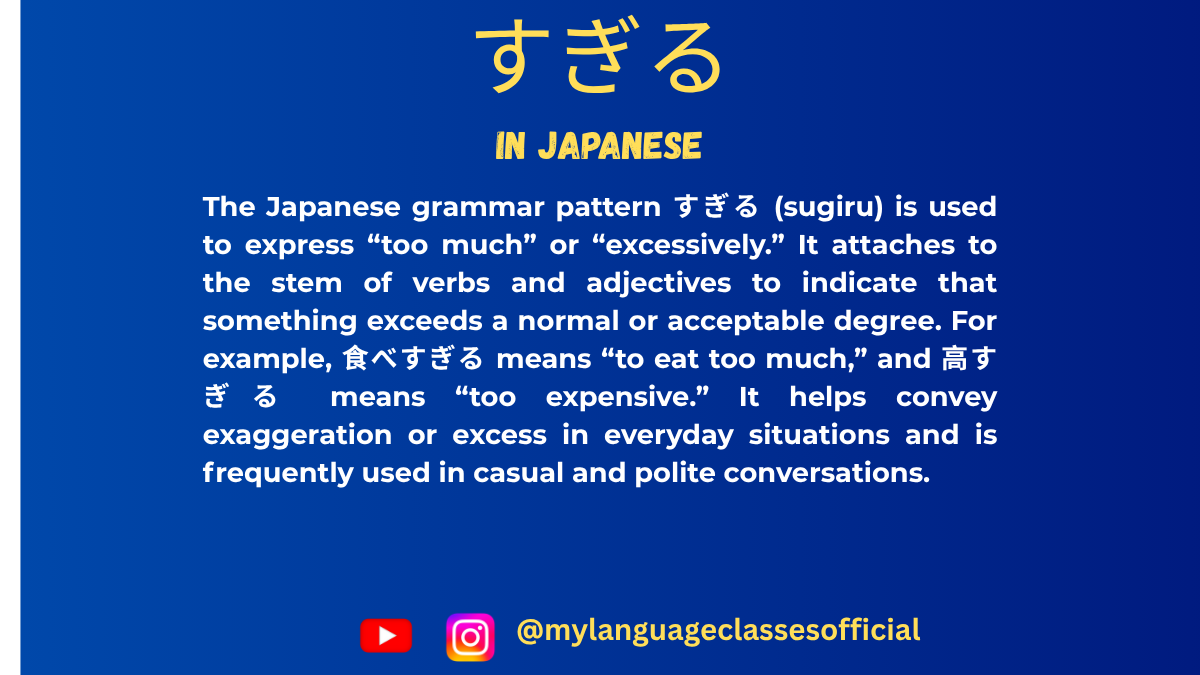
How to Use すぎる in Japanese | My Language Classes
Mastering すぎる: The Key to Expressing Excess in Japanese
When learning Japanese, one of the most versatile tools in your linguistic arsenal is the suffix すぎる (sugiru). This simple yet powerful expression allows you to convey the idea of “too much” or “excessively” with verbs, adjectives, and more. In this blog, we’ll explore how to use it, provide practical examples, and share cultural insights to help you avoid common mistakes.
What Does すぎる Mean?
At its core, すぎる means “to go beyond” or “to exceed.” When attached to the root of a verb or adjective, it transforms the phrase to mean “too much” or “overly.”
For example:- 食べすぎる (tabesugiru): to eat too much.
- 高すぎる (takasugiru): too expensive.
- 使いすぎる (tsukaisugiru): to use too much.
This construction works seamlessly in a wide variety of situations, making it an essential element of everyday conversation.
How to Use すぎる with Verbs
To use すぎる with a verb, follow these steps:
- Take the stem form of the verb (the verb without its final ます in polite form or る in dictionary form).
- Attach すぎる directly to the stem.
Here are some examples:
- 食べる (taberu) → 食べすぎる (tabesugiru): to eat too much.
- 飲む (nomu) → 飲みすぎる (nomisugiru): to drink too much.
- 使う (tsukau) → 使いすぎる (tsukaisugiru): to use too much.
Example sentences:
- 昨日、ラーメンを食べすぎてお腹が痛い。
(Kinō, rāmen o tabesugite onaka ga itai.)
Yesterday, I ate too much ramen, and now my stomach hurts. - 飲み会でお酒を飲みすぎないように気をつけてください。
(Nomikai de osake o nomisuginai yō ni ki o tsukete kudasai.)
Please be careful not to drink too much at the party.
How to Use すぎる with Adjectives
For adjectives, the method depends on whether you’re dealing with an い-adjective or a な-adjective:
1. い-Adjectives
Remove the final い, then add すぎる.
- 高い (takai) → 高すぎる (takasugiru): too expensive.
- 暑い (atsui) → 暑すぎる (atsusugiru): too hot.
Example sentence:
- この服は高すぎて買えない。
(Kono fuku wa takasugite kaenai.)
This clothing is too expensive to buy.
2. な-Adjectives
Simply add すぎる to the base form of the adjective.
- 簡単な (kantanna) → 簡単すぎる (kantansugiru): too simple.
- 静かな (shizukana) → 静かすぎる (shizukasugiru): too quiet.
Example sentence:
- 試験が簡単すぎてびっくりしました。
(Shiken ga kantansugite bikkuri shimashita.)
The test was too easy, and I was surprised.
Nuances and Cultural Tips
- Politeness Matters
In Japanese culture, expressing something as “too much” can sometimes feel blunt. To soften your tone, consider adding phrases like ちょっと (chotto) or using a more indirect expression:
- このラーメン、ちょっと辛すぎると思います。
(Kono rāmen, chotto karasugiru to omoimasu.)
I think this ramen is a little too spicy.
- Avoid Overusing It!
While すぎる is incredibly useful, overusing it can make your speech sound overly critical or negative. Balance it with positive expressions to maintain politeness and harmony in conversations. - Watch for Literal vs. Figurative Use
Sometimes, すぎる is used figuratively:
- 考えすぎる (kangaesugiru): to overthink.
- 頑張りすぎる (ganbarisugiru): to try too hard.
These can reflect emotional or mental states rather than physical actions.
Practice Makes Perfect
To truly master すぎる, try creating your own sentences! Use these prompts:
- What’s something you’ve done “too much” recently?
(食べすぎる, 寝すぎる, 遊びすぎる) - Describe something that felt excessive or overwhelming.
(高すぎる, 静かすぎる, 複雑すぎる)
Conclusion
The すぎる construction is indispensable for describing excess in Japanese. Whether you’re eating too much, overthinking, or facing something outrageously expensive, すぎる lets you express it all with precision and nuance.
So, next time you’re practicing Japanese, try experimenting with すぎる. Not only will it enhance your vocabulary, but it will also deepen your understanding of Japanese culture and conversational dynamics.
Happy learning, and don’t study すぎる (sugiru) much! 😊
If you enjoyed this lesson, be sure to check out more posts like this on my blog at My Language Classes. Don’t forget to subscribe my YouTube channel and follow me on Instagram for the latest language learning tips and lessons. Leave a comment below to share your thoughts, or ask any questions you have about nouns.
Happy learning! 😊
-
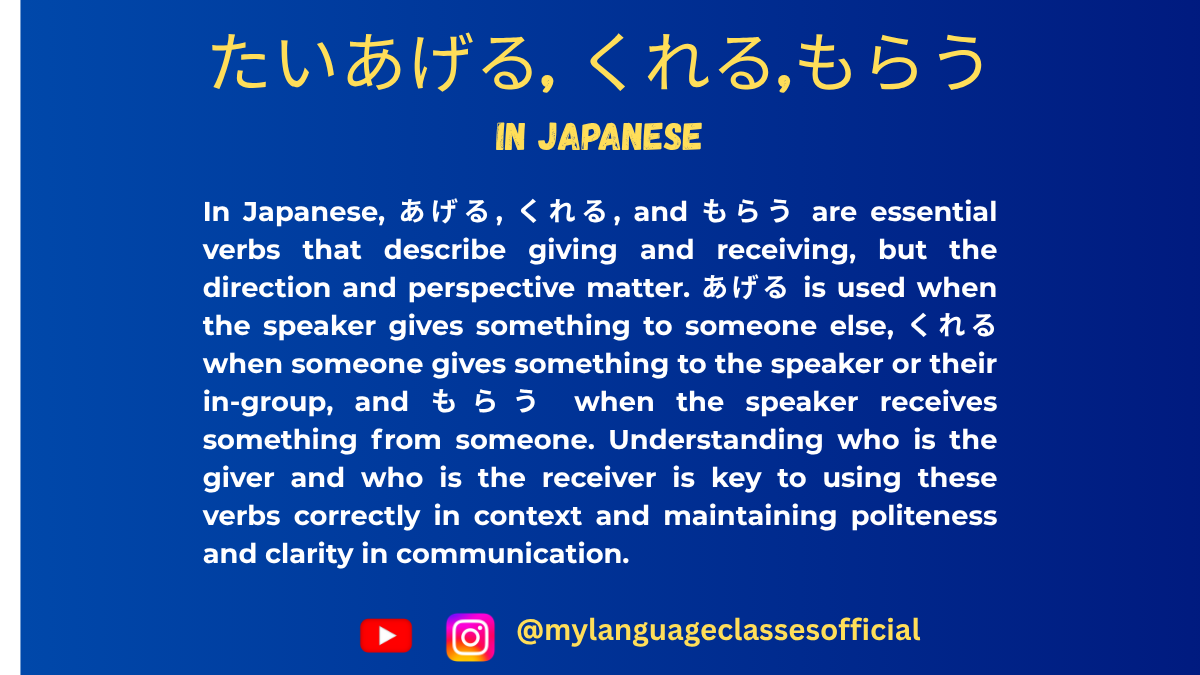
Mastering あげる, くれる, もらう in Japanese | My Language Classes
Mastering あげる, くれる, and もらう in Japanese
In Japanese, verbs of giving and receiving are key to navigating interpersonal relationships and expressing social dynamics. These verbs—あげる (ageru), くれる (kureru), and もらう (morau)—carry not only their literal meanings but also nuances reflecting social positioning and perspective. Understanding these verbs will elevate your Japanese communication skills and cultural comprehension. Let’s break them down with examples to guide your learning.
あげる (ageru): To Give (When You or Someone Gives to Others)
あげる emphasizes that the giver (the subject of the sentence) is offering something to someone else. It is often used when the recipient is considered equal to or higher in social status.
Example 1: Giving a Book to Your Mother
母に本をあげる
(Haha ni hon o ageru)
“I give a book to my mother.”Here, the giver (you) is offering the book to your mother. The に particle marks the recipient of the action, in this case, “mother” (母).
Example 2: Giving Chocolates to a Friend
友達にチョコレートをあげる
(Tomodachi ni chokorēto o ageru)
“I give chocolates to my friend.”あげる frames the action from the perspective of the giver, showing that the chocolates move from you to your friend.
くれる (kureru): To Give (When Someone Gives to You or Your Group)
くれる is used when someone gives something to you, your family, or your inner circle. It reflects the act of giving from the recipient’s (your) perspective.
Example 1: Receiving a Present from a Friend
友達がプレゼントをくれる
(Tomodachi ga purezento o kureru)
“My friend gives me a present.”Here, the subject is “friend” (友達), who is giving the present (プレゼント) to you. Notice how くれる focuses on the speaker’s perspective, framing the act of giving as it relates to you.
Example 2: Your Sister Gives You a Pen
妹がペンをくれる
(Imōto ga pen o kureru)
“My younger sister gives me a pen.”The action is centered on what you (the speaker) receive, with the subject being the giver (your sister).
もらう (morau): To Receive
もらう flips the perspective entirely, focusing on the receiver of the action. The giver is marked with the particle から or sometimes に, while the thing received is the direct object.
Example 1: Receiving a Book
本をもらう
(Hon o morau)
“I receive a book.”Here, the act of receiving is the focal point. The giver is understood or can be specified for clarity:
先生から本をもらう
(Sensei kara hon o morau)
“I receive a book from my teacher.”Example 2: Receiving a Gift from a Friend
友達からプレゼントをもらう
(Tomodachi kara purezento o morau)
“I receive a present from my friend.”から specifies the giver, highlighting the source of the action.
Key Differences and Social Nuances
- Perspective Matters:
- Use あげる when the speaker gives to someone else.
- Use くれる when someone gives to the speaker or their group.
- Use もらう when the speaker receives something.
- Hierarchy and Politeness:
These verbs subtly reflect social hierarchies. For example, when giving to someone of higher status, you may pair あげる with a more polite verb like 差し上げる (sashiageru). Similarly, くださる is a respectful form of くれる. - Indirect Speech and Cultural Sensitivity:
In Japanese culture, indirectness is often preferred. Instead of stating directly “I gave a gift,” one might say, プレゼントをあげました (Purezento o agemashita), emphasizing the act without being overly direct.
Practice with Full Sentences
Try these examples to reinforce your understanding:
- 私は友達にお菓子をあげた。
(Watashi wa tomodachi ni okashi o ageta.)
“I gave sweets to my friend.” - 母が私に時計をくれた。
(Haha ga watashi ni tokei o kureta.)
“My mother gave me a watch.” - 先生に鉛筆をもらいました。
(Sensei ni enpitsu o moraimashita.)
“I received a pencil from my teacher.”
Final Tips for Mastery
- Listen and Observe: Pay attention to how native speakers use these verbs in conversation or media. Notice the particles and nuances.
- Role-play Situations: Practice using these verbs in various contexts, like giving gifts, thanking someone, or describing exchanges.
- Expand Vocabulary: Learn related words like 差し上げる (to humbly give), くださる (to respectfully give), and いただく (to humbly receive).
By mastering あげる, くれる, and もらう, you’ll not only enhance your Japanese skills but also gain a deeper appreciation for the culture and its emphasis on relationships and social awareness.
If you enjoyed this lesson, be sure to check out more posts like this on my blog at My Language Classes. Don’t forget to subscribe my YouTube channel and follow me on Instagram for the latest language learning tips and lessons. Leave a comment below to share your thoughts, or ask any questions you have about nouns.
Happy learning! 😊
- Perspective Matters:
-

Mastering Question Words in Japanese | My Language Classes
Mastering Japanese Question Words
When learning Japanese, understanding how to ask questions is essential to communication. Whether you’re inquiring about someone’s day or seeking directions in Tokyo, mastering question forms will significantly enhance your confidence. In this blog post, we’ll delve into Japanese question words, how to use them, and the role of か (ka) for forming yes/no questions. Let’s get started!
Essential Japanese Question Words
Japanese question words are key for asking specific questions. Here’s a breakdown of the most common ones:
1. 何 (なに/nani) – “What”
- Examples:
- これは何ですか? (Kore wa nani desu ka?) – What is this?
- 何を食べますか? (Nani o tabemasu ka?) – What will you eat?
The word 何 changes depending on context:
- When followed by ですか (desu ka), it remains nani.
- With particles like を (o) or が (ga), it’s also nani.
- Before な (na)-row sounds, it often becomes なん (nan), e.g., 何時 (なんじ/nanji) – “What time?”
2. 誰 (だれ/dare) – “Who”
- Examples:
- 誰ですか? (Dare desu ka?) – Who is it?
- あなたは誰ですか? (Anata wa dare desu ka?) – Who are you?
For polite speech, you can use どなた (donata) instead of 誰.
3. どこ (doko) – “Where”
- Examples:
- トイレはどこですか? (Toire wa doko desu ka?) – Where is the bathroom?
- あなたはどこに住んでいますか? (Anata wa doko ni sunde imasu ka?) – Where do you live?
4. いつ (itsu) – “When”
- Examples:
- いつ来ますか? (Itsu kimasu ka?) – When will you come?
- 試験はいつですか? (Shiken wa itsu desu ka?) – When is the exam?
5. なぜ (naze) / どうして (doushite) – “Why”
- Examples:
- なぜ行きませんか? (Naze ikimasen ka?) – Why won’t you go?
- どうして泣いているんですか? (Doushite naite irun desu ka?) – Why are you crying?
While なぜ and どうして both mean “why,” どうして is more conversational, whereas なぜ is slightly formal.
6. いくら (ikura) – “How much”
- Examples:
- これはいくらですか? (Kore wa ikura desu ka?) – How much is this?
- 昼ご飯はいくらかかりますか? (Hirugohan wa ikura kakarimasu ka?) – How much does lunch cost?
Forming Yes/No Questions with か (ka)
Japanese yes/no questions are incredibly straightforward—just add か to the end of a sentence. Let’s break it down:
1. Verb + か
- Examples:
- 食べますか? (Tabemasu ka?) – Do you eat? / Will you eat?
- 映画を見ますか? (Eiga o mimasu ka?) – Will you watch the movie?
2. Noun + ですか
- Examples:
- 学生ですか? (Gakusei desu ka?) – Are you a student?
- 日本人ですか? (Nihonjin desu ka?) – Are you Japanese?
Adding か turns a statement into a polite question.
Bonus: Combining Question Words with か
You can combine question words with か to create open-ended questions:
- 何か (nani ka) – “Something”
- 誰か (dare ka) – “Someone”
- どこか (doko ka) – “Somewhere”
For example:
- 何か食べますか? (Nani ka tabemasu ka?) – Will you eat something?
- 誰か来ますか? (Dare ka kimasu ka?) – Will someone come?
Pro Tip for Learners
In informal conversation, か is often omitted:
- これ何? (Kore nani?) – What’s this?
- 誰? (Dare?) – Who?
Practice Makes Perfect
To solidify your understanding, try creating sentences using each question word. For instance:
- Where do you live?
- あなたはどこに住んでいますか? (Anata wa doko ni sunde imasu ka?)
- What will you eat?
- 何を食べますか? (Nani o tabemasu ka?)
Post your examples in the comments for feedback or ask additional questions to enhance your learning. Remember, the key to mastering Japanese question forms is consistent practice!
Happy learning! がんばってください! (Ganbatte kudasai!) 😊
If you enjoyed this lesson, be sure to check out more posts like this on my blog at My Language Classes. Don’t forget to subscribe my YouTube channel and follow me on Instagram for the latest language learning tips and lessons. Leave a comment below to share your thoughts, or ask any questions you have about nouns.
- Examples:

